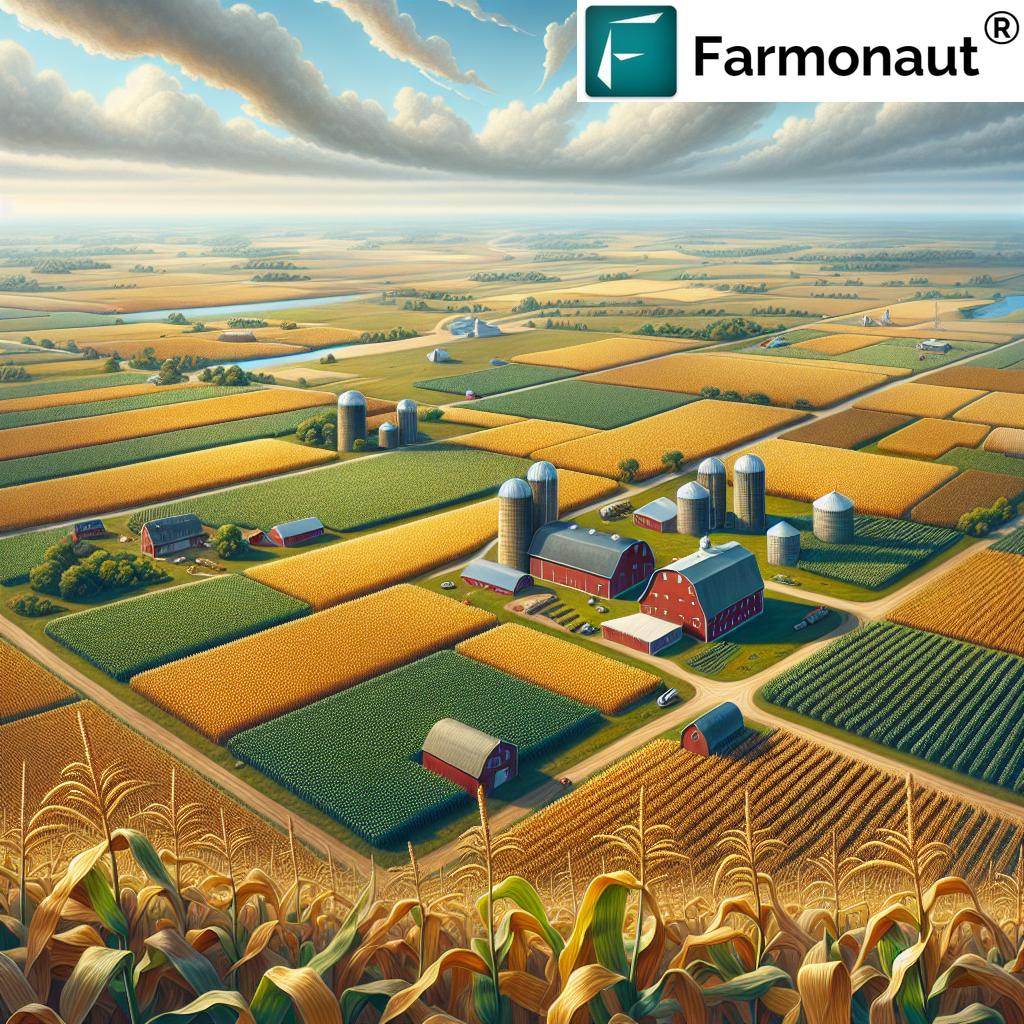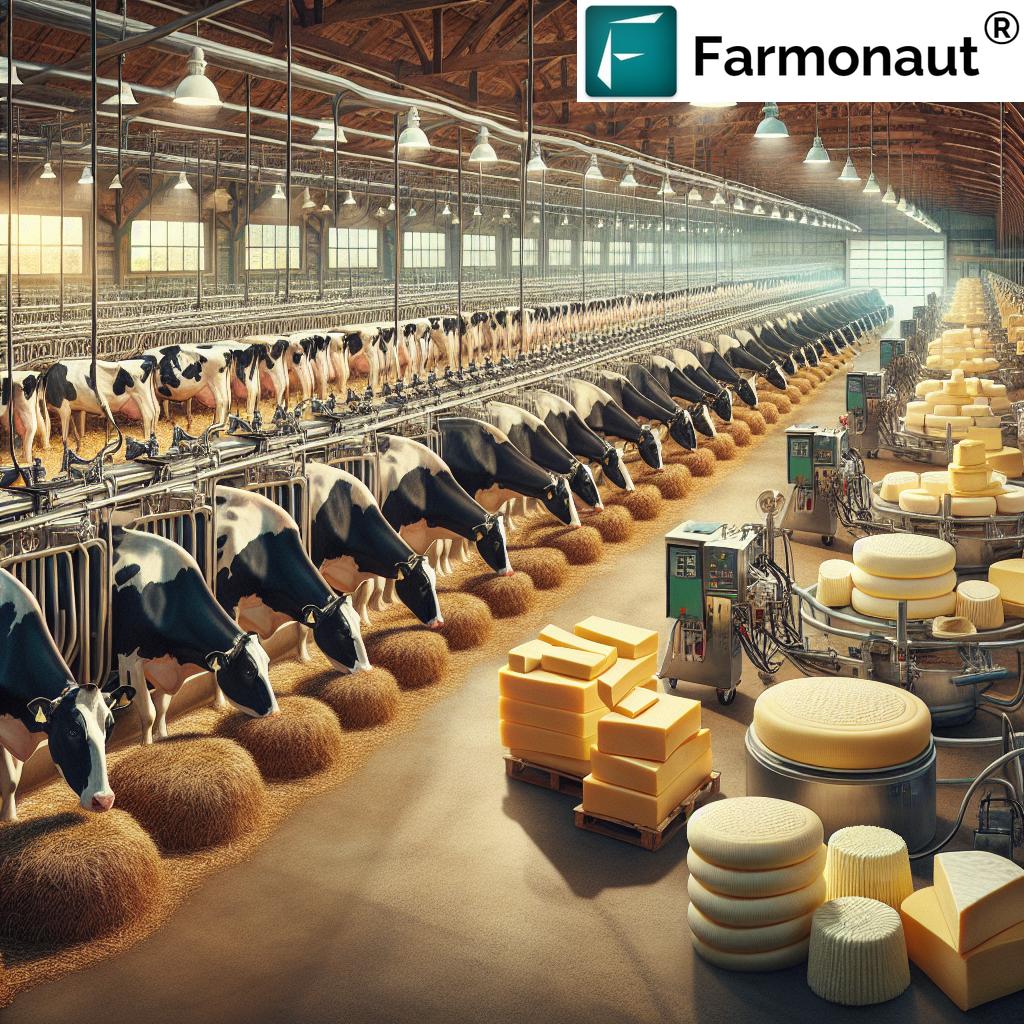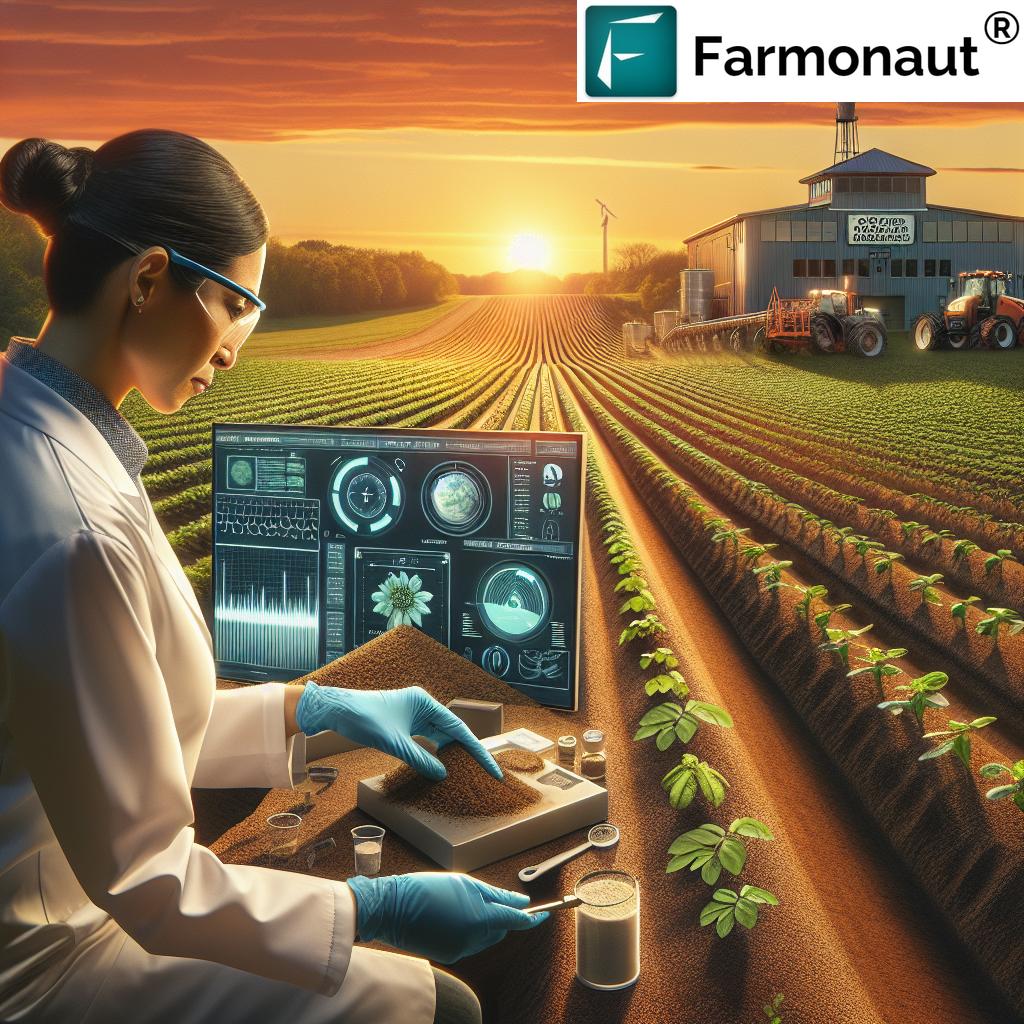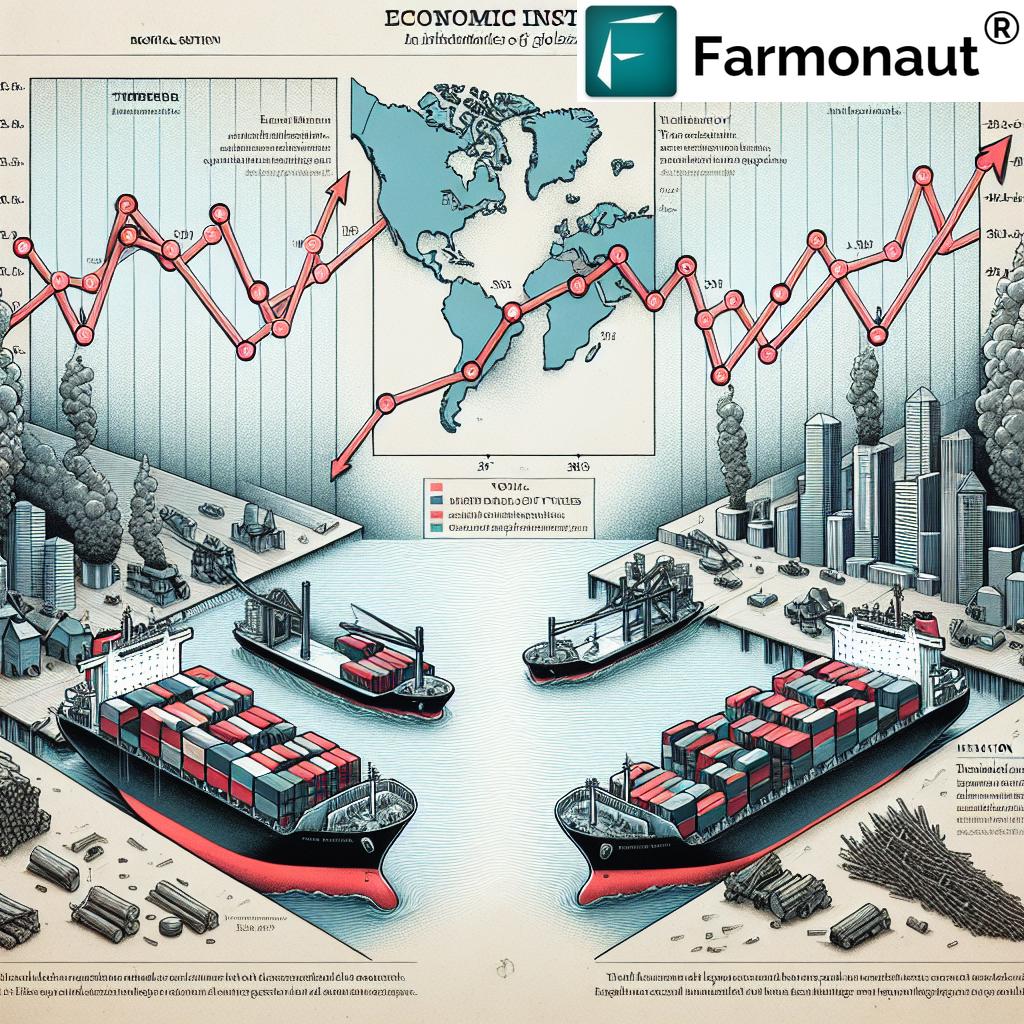Midwest Agriculture: 7 Powerful Facts on Sustainable Farming
Table of Contents
- Introduction
- Powerful Midwest Agriculture Trivia
- 1. The Breadbasket of America: Unmatched Crop Production
- 2. Crop Diversity: Beyond Corn and Soybeans
- 3. Livestock and Dairy: The Beating Heart of Midwest Farming
- 4. Economic Impact: Midwest Agriculture as an Economic Cornerstone
- 5. Facing Challenges: Trade Tensions and Climate Extremes
- 6. Innovations in Sustainable Farming Practices Midwest
- 7. Farmonaut: Fueling Precision, Sustainability, and Transparency
- Crop and Sustainability Practices Comparison Table
- Frequently Asked Questions (FAQ)
- Conclusion
- Farmonaut Subscription Plans
“The Midwest produces over 75% of the nation’s corn and soybeans, fueling both food and biofuel industries.”
The Midwest, often dubbed “America’s Heartland” and the Corn Belt, stretches across Illinois, Indiana, Iowa, Michigan, Minnesota, Missouri, Ohio, and Wisconsin. This region’s fertile soils and variable climate have nurtured a vibrant agricultural economy for generations. As we explore Midwest agriculture, we’ll uncover seven powerful facts—centered on production, sustainable farming practices, and the modern innovations guiding the future—shedding light on this region’s persistent economic and environmental significance within the United States and across the globe.
1. The Breadbasket of America: Unmatched Crop Production
When we refer to Midwest agriculture as the “breadbasket,” we’re not exaggerating. This iconic region, comprising the states of Illinois, Indiana, Iowa, Michigan, Minnesota, Missouri, Ohio, and Wisconsin, is essential for production of staple crops that feed the nation—and the world.
Let’s break down the scale and significance:
- Corn production in the Midwest isn’t just massive; it’s fundamental to both the food system and energy sectors, with the region producing well over 75% of the country’s corn. Fields of corn blanket the area, powering everything from animal feed and processed foods to the booming biofuel industry.
- Soybeans, a versatile crop for oils, tofu, feeds, and alternative proteins, are nearly as prominent, with Midwestern states together accounting for more than three-quarters of all national yields.
- Wheat—especially in parts of Ohio, Indiana, Missouri, and Michigan—complements this agricultural powerhouse, keeping American food shelves (and exports) full.
Historically, this dominance is enabled by remarkable soils—thick, nutrient-rich loess and mollisols—combined with a moderate, mostly predictable climate that offers enough warmth, rain, and seasonal change to maximize output and yield resilience.
This tendency toward high productivity has shaped not only the economic landscape of the region but also global agricultural markets.
Fun Fact: Some counties in Iowa and Illinois produce more corn than most entire countries!
2. Crop Diversity: More Than Just Corn and Soybeans
Although the Corn Belt image is iconic, Midwest crop diversity deserves equal celebration. Our landscape may seem uniform from above, yet Midwest agricultural products include a rich variety of fruits, vegetables, and specialty crops cultivated on farms big and small.
According to climatehubs.usda.gov, these are just some of the region’s highlights:
- Fruits: Apples, blueberries, tart cherries, cranberries, grapes, peaches, plums, raspberries, strawberries, watermelon.
- Vegetables: Asparagus, green beans, cabbage, carrots, cucumbers, onions, peas, bell peppers, potatoes, pumpkins, tomatoes.
- Other notable crops: Oats, tobacco, sweet corn, wheat, soybeans.
This diversity supports market stability when corn or soy prices are volatile, keeps local food systems robust, and fortifies community health with fresh produce. Small-scale and established family farms throughout Illinois, Michigan, Wisconsin, Indiana, Minnesota, and Ohio lead the way in midwest fruit and vegetable farming, often specializing in seasonal favorites like blueberries, cranberries, and apples thanks to microclimates and soil diversity.
It’s not just about food, either. Tobacco, for instance, remains an important cash crop for small farms, while pumpkins produced in central Illinois account for a massive portion of canned pumpkin goods across the United States.
Midwest crop diversity is crucial for soil health, pest resistance, and economic resilience—key ingredients for long-term sustainability.
3. Livestock and Dairy: The Beating Heart of Midwest Farming
While row crops fill the region’s fields, livestock and dairy farming in Wisconsin and beyond form the backbone of many rural economies. This sector, integral to the Midwest agricultural economy, powers the food supply and job creation in all Midwestern states.
- Pork Production: Iowa reigns as the U.S. leader in pork, fueling domestic markets and robust exports.
- Beef and Poultry: Missouri, Minnesota, and Indiana have growing beef and poultry industries, supplying meat packing plants locally and nationwide.
- Dairy Farming: Wisconsin is “America’s Dairyland.” This state produces about one-quarter of all America’s cheese and is rivaled only by California in milk output. It also leads in butter, producing approximately a quarter of the nation’s total.
With tens of thousands of family-operated and commercial-scale operations, the livestock and dairy industry is at the core of the region’s food ecosystem. Midwest agricultural products from these operations include meat, milk, cheese, butter, eggs, and processed foods, contributing enormously to both local diets and exports.
Diverse pasture landscapes—prairies, woodlots, and river valleys—support healthy, economically efficient, and welfare-friendly systems.
4. Economic Impact: Midwest Agriculture as an Economic Cornerstone
Midwest agriculture is more than tradition—it’s a modern cornerstone of the region’s economic vitality and the United States’ agricultural economy as a whole.
- In 2007, the market value of crop and livestock products sold by Midwestern states exceeded $76 billion—a number only rising with increased global demand, investments in infrastructure, and technological innovation.
- Exports: The Midwest drives export markets for corn, soybeans, pork, beef, wheat, and increasingly, dairy products, with billions of dollars flowing back into rural economies.
- Jobs: Thousands are directly or indirectly employed via farming, processing, equipment manufacturing, research, and logistics throughout Illinois, Indiana, Iowa, Michigan, Minnesota, Missouri, Ohio, and Wisconsin.
- Economic Multiplier: Every dollar generated by the agricultural sector supports local businesses, schools, infrastructure, and innovation.
More than just cash flow, Midwest agriculture holds social and cultural value. Farming traditions tie communities together—family farms, local fairs, farmer cooperatives, and food festivals all stem from the rich agricultural tapestry of the region.
Crop and Sustainability Practices Comparison Table
5. Facing Challenges: Trade Tensions and Climate Extremes
Despite the enormous contributions of Midwest agriculture, the sector regularly contends with significant pressures:
A. Trade Tensions and Tariff Escalations
- Recent trade disputes, including the escalation of tariffs on key exports like soy, corn, pork, dairy, and wheat, have created deep uncertainty and caused price volatility.
- Impact of trade tariffs on Midwest agriculture: States including Illinois, Indiana, Iowa, Minnesota, and Ohio are deeply affected, with worries over retaliatory measures undermining farmer livelihoods.
- Even temporary disruptions ripple through the entire agricultural economy of the Midwest, harming not just farmers but related industries and local economies.
B. Extreme Weather and Environmental Concerns
- The highly destructive 2020 Midwest derecho highlighted vulnerability, damaging millions of acres of crops and infrastructure, and reminding us of the risks from intensifying storms due to climate change.
- Droughts, floods, and shifting rainfall patterns make adaptation essential for the sector’s future.
- Soil erosion and nutrient runoff remain longstanding issues, threatening America’s most productive farmland and our clean water reserves.
6. Innovations in Sustainable Farming Practices Midwest
With growing threats from environmental change, market volatility, and policy shifts, sustainability and conservation efforts have become pillars of Midwest agriculture. Here’s how the region is rising to the challenge:
A. Soil Health and Regenerative Practices
- Crop Rotation: Alternating corn, soybeans, wheat, and legumes interrupts pest cycles, replenishes soil nutrients, and preserves yield.
- Cover Cropping: Planting rye, clover, or radishes post-harvest helps control erosion, increase organic matter, and lock in nutrients.
- Reduced Tillage: No-till, strip-till, and minimum-till systems keep soils intact, reducing erosion and carbon loss.
B. Efficient Water and Nutrient Management
- Drip irrigation and precision watering conserve resources in water-stressed areas.
- Buffer strips along waterways filter runoff and restore wildlife habitat.
- Nutrient management plans—backed by satellite and soil data—reduce fertilizer waste and protect local aquifers and rivers.
C. Livestock Integration and Dairy Innovation
- Rotational grazing techniques maintain pasture health and reduce the environmental impact of animal agriculture.
- Manure management systems turn waste into energy and valuable fertilizer, contributing to carbon footprint reduction.
- Dairy farming in Wisconsin is pioneering biodigesters and methane capture technology, complementing centuries-old cheese-making traditions.
D. Climate Adaptation
- Investing in drought-tolerant hybrids and smarter planting windows helps maintain yields through record-breaking heat and erratic seasonality.
- Sustainable farming practices Midwest have collectively reduced soil erosion by up to 40% over two decades, showing measurable environmental gains.
Organizations like The Nature Conservancy and many local stakeholders are at the forefront, helping growers balance food productivity with stewardship through technical assistance, demonstration projects, and conservation incentives.
7. Farmonaut: Fueling Precision, Sustainability, and Transparency
As the Midwest agricultural sector becomes increasingly data-driven, adopting innovative technology is crucial for sustainability and competitiveness. This is where solutions like Farmonaut step in, transforming how we manage farmland and optimize production.
Farmonaut’s Impact on Midwest Agriculture
- Satellite-Based Crop Health Monitoring: With Farmonaut, farmers gain real-time multispectral imagery, enabling early detection of pests, disease, drought stress, and nutrient deficiencies—leading to more timely and precise interventions that improve both yields and sustainability.
- AI Advisory for Smarter Decision-Making: The Jeevn AI system analyzes a farm’s satellite data, local climate, vegetation indices, and provides actionable crop-specific recommendations—including irrigation alerts, fertilizer schedules, and pest management tactics.
- Blockchain Traceability: In a world where food provenance matters, Farmonaut’s product traceability tools offer supply chain confidence. Every step of a Midwest-grown product—from field to processor to supermarket—can be recorded and verified, enhancing transparency, safety, and trust.
- Resource and Fleet Management: Large farms and agribusinesses can harness Farmonaut fleet management tools to optimize vehicle routes, reduce fuel use, and keep machinery running efficiently, lowering operational costs and environmental impact.
- Carbon Footprinting: Sustainability is measurable, and Farmonaut’s carbon footprint tracking feature empowers farmers and businesses to monitor greenhouse gas emissions, set reduction targets, and comply with emerging carbon regulations.
Discover Farmonaut Agro-Admin app for large-scale farm management and plantation tracking.
Farmonaut’s mission is to democratize precision agriculture, making advanced monitoring, traceability, and sustainability accessible and affordable for Midwest farmers and beyond. Their satellite-powered platforms run on Android, iOS, and browser, serving everyone from individual growers to state governments—empowering smarter, greener agriculture.
Quick Benefits of Farmonaut for Midwest Growers
- Increase yields by targeting inputs and reducing waste.
- Improve sustainability with real-time soil, crop, and weather data.
- Reduce risk and qualify for better insurance with crop verification tools.
- Build transparency for consumers and supply chain partners.
- Track and lower your carbon footprint—future-proofing operations.
Frequently Asked Questions (FAQ)
What states make up the core of Midwest agriculture?
The core Midwest agricultural region incorporates Illinois, Indiana, Iowa, Michigan, Minnesota, Missouri, Ohio, and Wisconsin, known collectively as the “Corn Belt.”
Why is corn so dominant in the Midwest?
Corn production in the Midwest thrives due to highly fertile soils, reliable rainfall, and a climate well-suited for high-yield hybrids. Corn is vital for animal feed, processed foods, ethanol, and biofuels, accounting for over 75% of national corn output.
What other crops are important besides corn and soybeans?
The Midwest also cultivates apples, asparagus, green beans, blueberries, cabbage, carrots, sweet and tart cherries, cranberries, cucumbers, grapes, oats, onions, peaches, plums, peas, bell peppers, potatoes, pumpkins, raspberries, strawberries, sweet corn, tomatoes, watermelon, and wheat, among others. Diversity supports soil health and economic stability.
How central are livestock and dairy to the Midwest?
Livestock and dairy farming are crucial, with Iowa leading in pork and Wisconsin cheese production reaching national leadership. Cattle, poultry, eggs, beef, butter, and milk are important products for both domestic and export markets.
How does Midwest agriculture affect the economy?
Midwest agricultural products provide billions in sales and exports, forming a cornerstone of the region’s economy. This includes job creation, rural prosperity, and broader economic impact.
What are the main environmental and trade challenges?
Trade tensions, tariff escalation, and retaliatory measures threaten the stability of key exports (like soy, dairy, corn, pork, and wheat). Environmental risks include soil erosion, waterway pollution, and unpredictable weather events such as derechos, flooding, and droughts.
What sustainable practices are Midwest farmers adopting?
Practices like crop rotation, cover cropping, reduced and conservation tillage, riparian buffer strips, precision irrigation, AI-driven advisory systems, nutrient management, and greenhouse gas tracking are all gaining traction, helping farmers reduce environmental footprints while securing productivity.
How can Farmonaut support Midwest farming?
Farmonaut equips farmers and agribusinesses with satellite-powered monitoring, AI advisories, blockchain traceability, carbon accounting, and fleet/resource management, leading to better yields, efficiency, and sustainability. Try Farmonaut now on web or mobile!
Conclusion: The Enduring Impact of Midwest Agriculture
From the historic Corn Belt to the fertile valleys dotted with orchards and dairy barns, Midwest agriculture continues to shape our nation’s landscape and economy. Its unmatched production, diverse crops, and robust livestock sectors provide food security, export power, and rural livelihoods like nowhere else.
Yet, it’s the sustainability efforts, innovative practices, and fast adoption of technologies like Farmonaut that promise a bright, resilient future. With an unwavering commitment to stewardship—from soil health to carbon management, resource optimization to transparency—Midwestern farmers not only feed America but set a global standard for responsible, sustainable farming.
As we look to years ahead, it’s clear that the Midwest agricultural sector will remain as pivotal as ever—adapting, innovating, and thriving while balancing the needs of people and planet. The story of the Midwest is not just about what we grow, but how we grow it—and who it benefits.
Farmonaut Subscription Plans
Ready to unlock affordable precision agriculture with Farmonaut and boost your sustainable farm management? Explore our flexible subscriber packages below—tailored for every need, from Midwest family farms to large agribusinesses, agri-researchers, and government agencies.

















